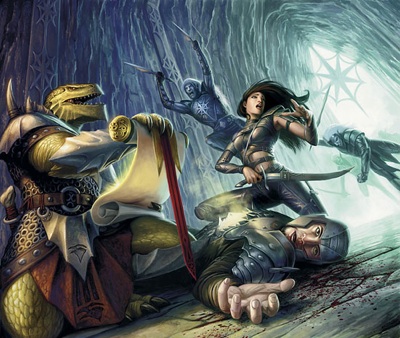Bringing Characters Back
A lot of players become very invested in their characters, and would not like to permanently lose them in a campaign. That's why a lot of games make it very difficult for characters to die at all. Some of them allow one or more options to stabilize, others don't even typically feature lethal combat (Like superhero settings.) But when player characters do die, I always follow up the session by asking the player if they think they will want the character back. If no, then they have a brand new character in the form of whatever new concept they have chosen to continue the campaign with. If yes, then I have time to come up with an explanation for how their first character will return. This isn't as difficult as it sounds, since comic books have been bringing characters back to life all the time.
If I wish to put the onus on the players, I can associate the character's resurrection with some kind of special quest or expensive cost like old-school D&D. Usually, though, there is some way to bring the character back or reveal their death was not what it seemed. This means that the player spends two or three sessions as a different character. It may sound like a short time, but it seems longer for a player itching to play their favorite character again, and it serves as a decent motivation for a player to avoid falling in battle.
There is something to be said for letting the fallen rest in peace, however. For one thing, it can create a cool and dramatic narrative for players who like the story-telling aspect of the game. Letting character death happen naturally lends a dramatic weight to the game's events, and gives players the opportunity for new experiences with their new character. Be sure to have open communication with your players if you want to make death "stick" more often, and surely don't implement perma-death if they carefully crafted a character with the intention of taking them to the campaign's end.
Making It Matter
Finally, if you are running a story-focused campaign, (especially with fleshed-out character backstories and personalities) try not to let death occur as a trivial or anti-climactic incident. I typically reserve even the possibility of a lethal outcome for serious and dramatic encounters. Minor events like minion ambushes and booby traps should bring the characters down to their last leg, but having a character dropped by some bad luck and a half-dead goblin archer will make that moment seem pretty nihilistic by most counts There are some groups that will work well in, but make sure that's your audience before going for it.
A good rule of thumb is that a character's death should occur at a point that it would make for a good story to tell. Sometimes this means it is a dramatic encounter with a major nemesis, sometimes it might be something ironic and darkly comic enough that I know the player will appreciate the hilarity. The point is that the player should be able to greet his fate like the legendary Vikings of yore, with a smile on his face and a laugh on his breath! Valhalla or bust!
Happy ventures!


No comments:
Post a Comment